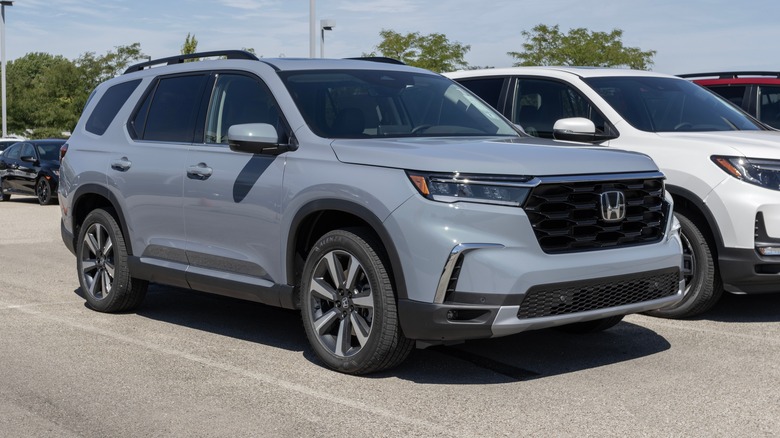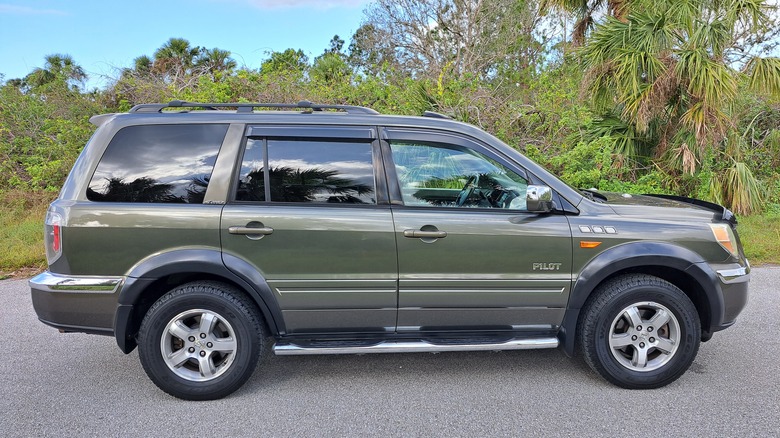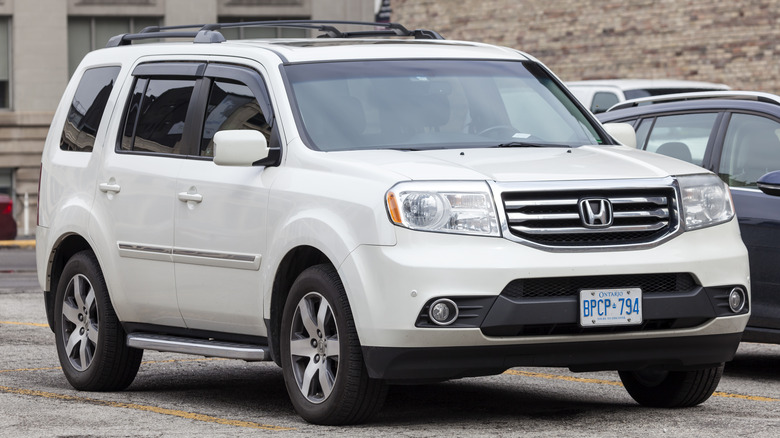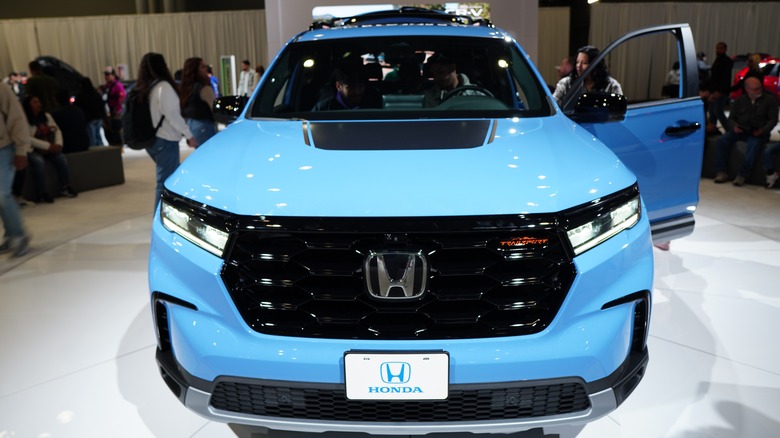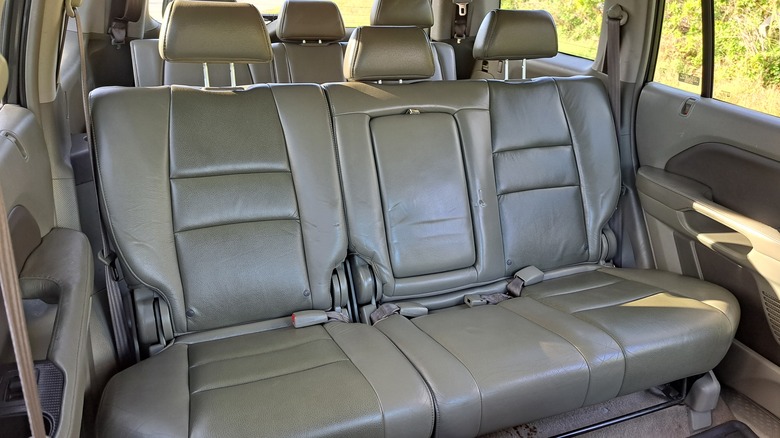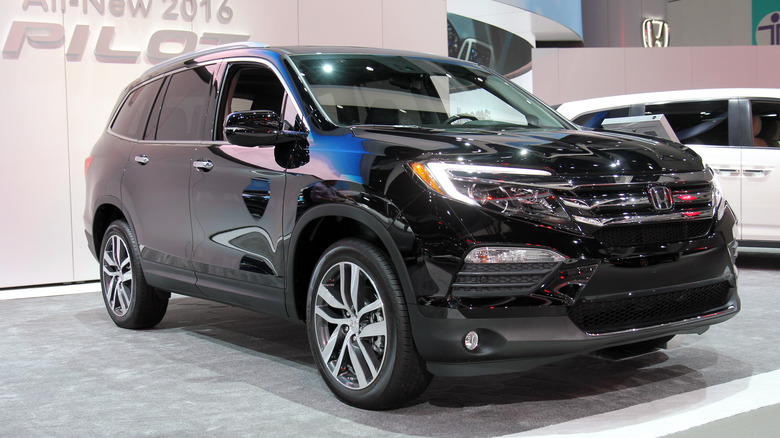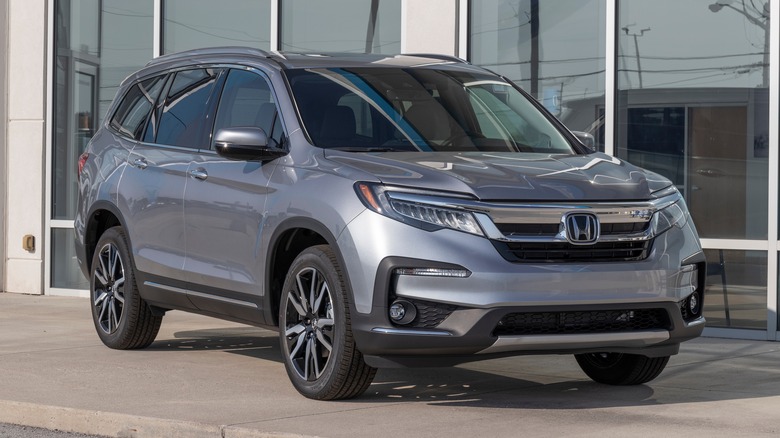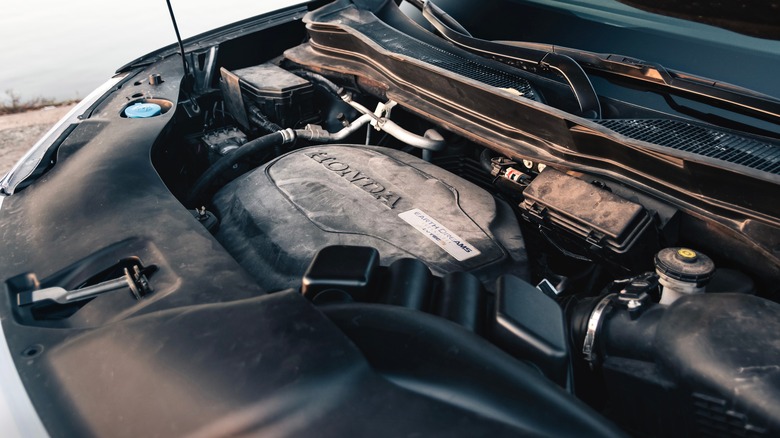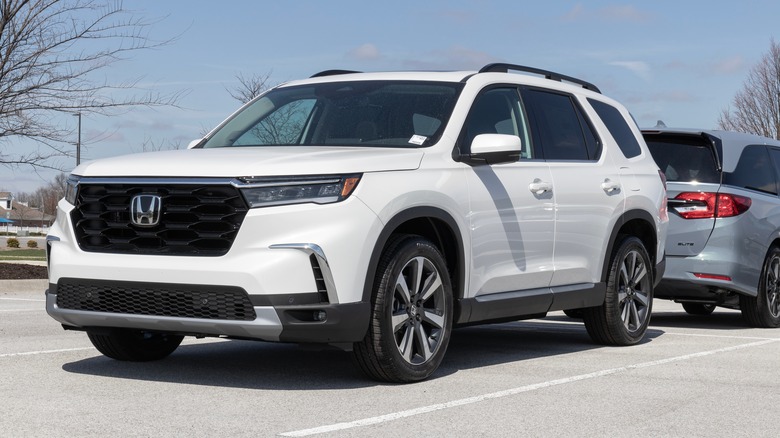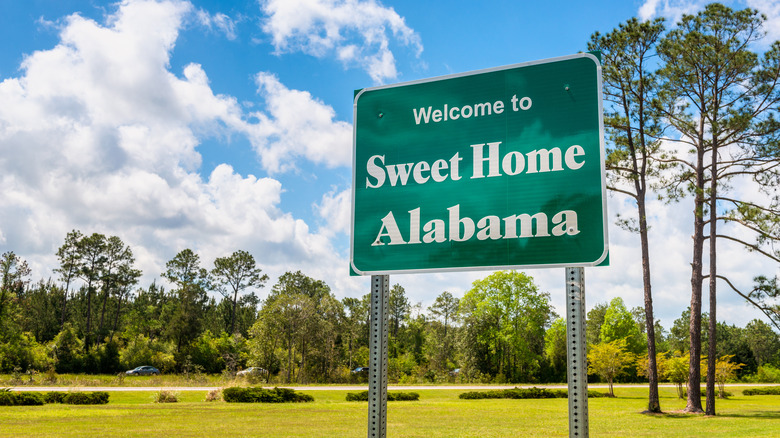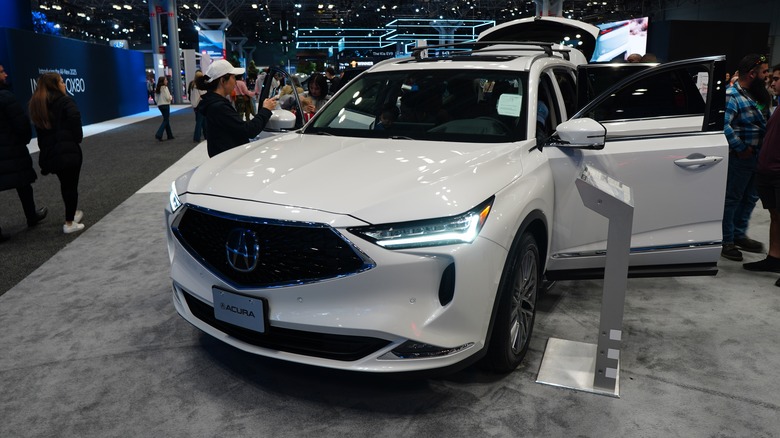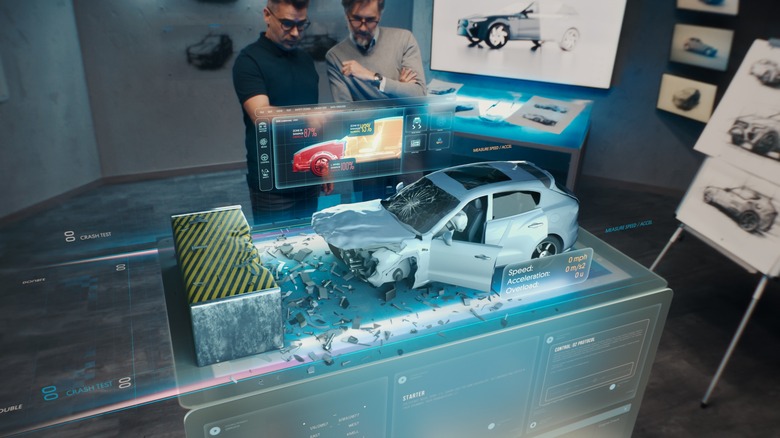11 Things You Should Know Before Buying A Honda Pilot (New Or Used)
The Honda Pilot is the largest SUV in Honda's lineup. It competes directly with a very populated three-row SUV segment that includes the Kia Telluride, Hyundai Palisade, the Mazda CX-90, and the Chevy Traverse. It's a unibody design, so it's not quite as truck-like as the Chevy Suburban and similar vehicles but most shoppers don't seem to mind. It's bigger overall than the Honda CR-V and the Honda Passport by quite a hefty margin. The Honda Passport, Honda's second biggest SUV, has a passenger volume of 114.9 cubic inches while the Pilot has 158.4 cubic inches as of 2024. That should give you a clue how much more space you get in the Pilot.
It's not an enthusiast car like the Honda S2000 or the Civic Type-R. It's a family hauler designed to squeeze in as many people and as much stuff as possible. The only vehicle in Honda's lineup with more space is the Honda Odyssey minivan, which is excellent in its own right. The van carries more stuff, but the Pilot has better ground clearance and comes with all-wheel drive, two things the Odyssey lacks. So, if you're shopping for a family vehicle, the Pilot is a pretty reasonable path to take.
With that said, there's a lot to know about the Honda Pilot, especially if you intend on buying it used. Here is a brief history of the Honda Pilot along with some fun facts and important details you may want to consider before you make a purchase.
Honda launched the Pilot in 2003
Honda has been gracing roadways with the Honda Pilot since 2003. Initially, Honda developed the Pilot to compete with body-on-frame SUVs of the era. The three-row SUV landscape looked a lot different back then than it does now and included mostly body-on-frame SUVs like the Cadillac Escalade, Ford Expedition, Toyota 4Runner, and Chevy's Trailblazer and Tahoe. So, when Honda brought out the unibody Honda Pilot, it was cutting against the established grain of the time period.
The Pilot's unibody design gave it some advantages over its body-on-frame competition. It's well established that unibody vehicles feature better handling at a lower cost with better safety scores and fuel economy. So, while the body-on-frame competitors could technically tow more and had better off-roading chops, the Pilot was made for hauling people and things on city streets and highways, which the capable SUV excelled at. It was not the only unibody SUV on the road, but it was one of the few that featured three rows.
Honda worked quite a bit on the Pilot in its early years. It only took two models before Honda upgraded the engine from its 240 horsepower V6 to a 255 horsepower V6 that also included a variety of new features such as a drive by wire throttle system. In that same time frame, Honda added a sliding second row seat for easier accessibility to the third row, some revised styling, and Honda's Satellite-Linked Navigation System. The Pilot was already pretty stacked by the time the second generation came out.
The Honda Pilot has four generations
Potential buyers of the Honda Pilot should know that there are four generations, each with their own set of features. The first-generation Pilot lasted from 2003 through 2008, the second from 2009 through 2015, the third from 2016 through 2022, and the fourth generation started in 2023 and is still going as of this writing. There were also a handful of facelifts over the years with the first generation getting one in 2006, the second generation getting one in 2009, and the third generation getting one in 2016.
There are myriad changes from generation to generation while some other things stayed the same. For example, the Honda Pilot has always been powered by a V6 engine and has always had an all-wheel drive option. The engines have gotten better over the years, although Honda tends to keep the same engine in a generation all the way through to the end. The only exception was the first generation which received a mid-cycle engine upgrade. Most other mid-cycle drivetrain updates were for the transmission.
In terms of technology, the most recent generation is obviously the most technologically advanced. Honda tends to keep up with technology pretty well in its vehicles. For example, the 2016 Honda Pilot, the first year of the third generation, did not have Android Auto or Apple CarPlay. It was added in the 2017 model year right before its 2019 refresh. Of course, all four generations have distinctive styling, so you can pretty easily tell them apart.
It is Honda's second best selling SUV
The Honda CR-V is the undisputed king of Honda's SUV lineup, but the Pilot holds a firm grasp on second place. In fact, of Honda's top ten selling SUVs of all time, the second generation and third generation Pilots rank fifth and fourth, respectively. Complete sales data isn't available for the original Honda Pilot but from 2005 through 2008, Honda sold over 400,000 Pilots, which is still very respectable. In total, Honda has sold 2.3 million Pilots from 2005 through 2023, so there are a lot of them out there.
The second-generation Pilot put up nearly a third of those with 750,000 units. It complimented the Honda CR-V at the time by giving shoppers something a little bigger with some extra seating for larger families. The third-generation Pilot upped the ante significantly by selling just over 900,000 units during its seven-year lifespan. It averaged over 100,000 units per year, so if Honda had kept the third generation around for one more year, it's likely that the third generation Pilot would've been the first to hit one million units sold.
The fourth generation Pilot is keeping the pattern going so far with 110,000 units sold in its first year of availability. That is doubly impressive considering that it's still powered by a V6 engine in an era where more and more shoppers are opting for a hybrid. Even so, people seem to really like the steady V6 engines that Honda puts in these cars and the fourth generation seems to hit most of the right notes.
It has always been a three-row crossover
The Honda Pilot has always been consistent with its offerings. That includes the three rows that each variant offers no matter which year you buy it. Some competitors, such as the Kia Sorento, started with two rows of seats and then eventually added a third row to better adapt to market conditions. The Pilot has never done this and is still a three-row crossover even to this day. The next size down, the Honda Passport, is Honda's largest two-row crossover.
With that said, the three rows haven't always been in the same configuration. The Pilot didn't get sliding second row seats until 2004. In addition, some models come with the second-row bench seat, providing eight seats for passengers while some other trim levels change the middle row to two captain's chairs, reducing the number of potential passengers to seven. You'll find most seven seat configurations on the newer models, including the 2024 and 2025 models of the Pilot. However, the third generation also has a seven-seat option on higher trims.
Earlier models didn't tend to have second row captain's chairs, but it doesn't mean that the second row was less serviceable. For example, the second-generation Pilot had a second row that was capable of fitting three child's seats side-by-side. That's not a feat you commonly see in modern vehicles. However, in all of the Pilot models, the third row can be a bit cramped for adult-sized passengers, so it's something you may want to take into consideration if you plan on going on road trips with a lot of tall people.
The 2003, 2005, and 2016 models have the most reliability issues
Honda is generally known as a reliable brand. Online websites like RepairPal and Consumer Reports have Honda ranked highly on the reliability charts and consumers recognize Honda as a typically reliable brand. However, as these things tend to go, not every model from every automaker is good and the Honda Pilot is no exception. So, while you should get good reliability out of most Pilots, there are a few years that you may want to avoid.
The models with the worst track records seem to be the 2003, 2005, and 2016. All three of those years saw Honda introduce a new engine into the lineup with 2003 and 2016 being years where Honda released an all-new Pilot generation, so the fact that they had some woes makes sense. The 2003 Pilot boasts a greater number of repairs needed than normal but none of the repairs are too bad, which means the 2003 Pilot is about average overall in terms of long-term cost for a vehicle over 20 years old. That's not terrible when it comes to reliability, but you can expect to see the mechanic a little more frequently.
The 2005 and 2016 Pilots are much the same way. Neither of them has any consistent, major issues. However, both model years tend to need repaired more often for minor things, resulting in a cost of ownership that is slightly above average thanks to an increased chance of needing a mechanic versus other crossovers.
The third generation Honda Pilot is the most reliable
If you take out 2016, the rest of the third generation of the Honda Pilot is going to be your best bet for reliability. The biggest reason is because they are newer vehicles with fewer miles on them. Thus, if you buy used, you're more likely to get into them before the mileage has piled up and more serious issues have a chance to show their ugly faces. The 2006, 2007, and 2008 model years are also pretty good if you're looking for something older.
In addition to being more reliable, there are also fewer recalls on newer Pilots. The 2021 Pilot has eight recalls whereas the 2005 Honda Pilot has 15. That is subject to change as the vehicles age, but for the time being, the newer models have had fewer things that have warranted a recall versus older models. Plus, when you buy a model with fewer miles, you have more control of the maintenance in the car's earlier life, thus helping it to live longer. The Honda Pilot, in general, is rated to last around 200,000 miles but you do need proper maintenance in order to hit those kinds of numbers consistently.
In short, if you want a Honda Pilot that's going to last longer, you'll typically need to buy a newer one with fewer miles. Very nearly all Honda Pilots we looked at had similar annual repair bills, per RepairPal, with only a couple of model years going above the average in this instance.
Every Honda Pilot has a six-cylinder engine
It's been mentioned a few times, but every variant of the Honda Pilot comes with a V6 engine. It's one of the few things that all Pilots have in common given the generations and mid-cycle refreshes the vehicle has had over the last two decades. Honda keeps it pretty simple here. From 2003 to 2022, every Honda Pilot came with a SOHC V6 engine. It wasn't until the fourth generation came out that Honda finally switched it over to a DOHC V6.
The 2003 and 2004 models had a 3.5-liter V6 that packs 240 horsepower and 242 lb.-ft of torque. The 2005 model upgraded that to 255 horsepower and 250lb.-ft of torque. Honda would revamp the engine again in 2006 through the end of the first generation but the change did weaken the engine slightly to 244 horsepower and 240 lb.-ft of torque. Honda became a lot more consistent after this. The second-generation Pilot had one 3.5-liter V6 with 250 horsepower and 253 lb.-ft of torque that it kept for the whole generation.
Similarly, the third-generation Pilot had a 3.5-liter V6 rated for 280 horsepower and 262lb.-ft of torque. The only change to the drivetrain during that entire generation was a swap to only offering a nine-speed automatic in 2021 and 2022. So far, the fourth generation is following along with a single 3.5-liter DOHC V6 with 285 horsepower and 262 lb.-ft of torque. It's mated to a 10-speed automatic.
The most expensive Honda Pilot is $54,000
Many automakers like to take the upper trims of vehicles to absurd levels. While $54,000 isn't exactly pocket change in 2024, it's also not nearly as bad as some other offerings. The Honda Pilot has always been known to be relatively affordable compared to its competitors. For example, let's look at a random year. The 2009 Pilot maxed out at $40,095 for the Touring trim, all-wheel drive, and a rear entertainment system for the passengers. The Chevy Tahoe from that same year maxed out at $52,520 for the top trim with all-wheel drive.
These days, the Honda Pilot about matches its competition. The highest trim of the Kia Telluride starts at $53,385, which is about the same amount as a top end Pilot. However, the fourth generation Pilot is more upscale than the prior generation models. After all, the first, second, and third generation Pilots didn't sport 10.2-inch touch screens, Honda's upgraded all-wheel drive systems, and 20-inch, glossy black wheels. Most of them also didn't include ventilated front seats or a panoramic sunroof either.
With that said, the further back you go, the more reasonable prices become. As of this writing, a top trim 2022 certified preowned Pilot will run you about $34,500 depending on location. A used 2012 Honda Pilot costs under $10,000 most of the time and a first-generation Pilot can go for between $4,000 and $6,000 depending on trim and location. That means there's a Pilot for nearly every price range.
The Honda Pilot is made in North America
Honda uses the word "America" a lot in its advertising for the Pilot and for good reason. The Honda Pilot was initially designed in Raymond, Ohio and Torrance, California. The first years of the Honda Pilot were manufactured in the Honda Canada Manufacturing Plant in Alliston, Ontario. In fact, the entire first generation was made there. The Alliston, Ontario plant is still open and still makes cars to this day and celebrated its nine-millionth vehicle produced in 2020. These days, the Alliston plant makes the Honda Civic and the Honda CR-V.
From the second generation on forward, the Honda Pilot has been made in Honda's Alabama plant. The plant is rather famous in Honda lore. It opened its doors in 2001 and the first car it produced was the 2001 Honda Odyssey. It would go on to add the Honda Passport, Honda Pilot, and the Honda Ridgeline. The plant is big enough that it offers plant tours and even donates money to local causes, like a 2023 battle of the bands competition for historically black colleges and universities.
The Alabama plant and the Canada plant are joined by the Marysville, Ohio plant that specializes in making the Honda Accord, Acura TLX, and the Acura ILX. It's been making the Accord at least since 1982 and it's one of Honda's longest running manufacturing centers in the US. You won't see the Honda Pilot there, though.
It shares a platform with the Acura MDX
Acura is Honda's luxury brand and a good choice for folks looking for what Honda offers but in a more upscale package. As such, all the big vehicles in Honda's lineup have Acura counterparts. The Honda Accord and the Acura TLX, for example, share a platform, many of the same components, and as such, a similar body style and driving demeanor. Similarly, the Honda Pilot and the Acura MDX also share a platform with one another and are basically siblings in the Honda and Acura lineup.
The Honda Pilot came first by two years, so the MDX is technically based on the Pilot and not the other way around. Both vehicles have shared a platform ever since. Thus, if you notice that one looks a little bit like the other, that's intentional. In addition, both SUVs are powered by the same 3.5-liter V6 engine that outputs similar horsepower. Both are also mated to a 10-speed automatic. Even the fuel efficiency is similar in both vehicles.
The price is the biggest difference between the two. The Acura's V6 is slightly more powerful, and the interior has more upscale materials and features than the Pilot. If you're shopping for a Pilot and you want one that offers more luxury, the Acura MDX is worth looking for since it's basically a more luxurious Pilot.
The Honda Pilot usually scores well on crash test ratings
No matter which Pilot you opt for, the safety numbers are pretty good. As per the IIHS, no Honda Pilot does poorly in crash test ratings. With that said, testing has changed quite a bit from the Pilot's earliest days in 2003 to today, so it goes without saying that the newer the Pilot, the more strenuous its crash safety tests were.
The first-generation Pilot scored pretty well in its crash test ratings. It passed all of the IIHS' tests with the highest scores except one small dent in the structure and safety cage rating, which was merely acceptable. The second generation was less impressive and had the worst test scores of the four Pilot generations. Honda cleaned it up with the third generation which has vastly better overall scores by the IIHS than the first and second generations while the fourth generation keeps up with the third generation.
So, if you want the safest Honda Pilot, you'll want to go for a third or fourth generation model. The first and second generations still did well for their era, but not nearly as well as newer Pilots. That shouldn't come as a surprise as safety is one of the things that gets updated with new generations of most vehicles.
